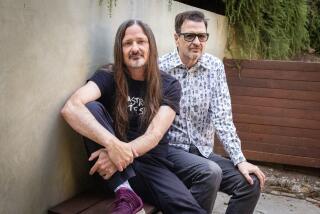FLEETWOOD MAC RESTORED
- Share via
OK, OK, so the faces we used in Record Rack last week to rate albums were stupid. While we launch a study to come up with a better symbol for rating the records, we’ll go with the old standby of 1 to 4 checks. Translation: = “Great Balls of Fire”
= “Good Vibrations” = “Maybe Baby” = “Running on Empty”
“TANGO IN THE NIGHT.” Fleetwood Mac. Warner Bros.
How does the definitive group of the late ‘70s make out a decade later?
Very well, thank you. Combining the experimentalism of 1979’s “Tusk” and the crisp pop sense of 1977’s multi-multi-million selling “Rumours,” “Tango” is as arresting and unique a work in its time as those albums were in theirs.
And though Lindsey Buckingham, Christine McVie and Stevie Nicks each still function pretty much autonomously as songwriters, the group’s first album since 1982’s uninspired “Mirage” carries the most unified feel of any Fleetwood Mac LP since the ones predating Buckingham and Nicks arrival in 1975.
One reason is the usual solid foundation of Mick Fleetwood’s tribal drumming and John McVie’s easy-to-overlook bass playing. The main one, though, is Buckingham. As the album’s co-producer (with Richard Dashut), arranger and dominant writer/singer, he employs the same distinctively adventurous approach he explored first on “Tusk” and later on his two excellent solo albums.
Buckingham’s pop pointillism favors mosaics of small, staccato sounds. But since the elements never quite fit together, the album is characterized by a pervasive, unsettling sense of weirdness.
In Buckingham’s hands, a simple, pretty little tune like Christine McVie’s “Mystified” becomes an intricately detailed miniature, while on his own songs he combines dozens of whispers into sometimes harrowing screams. Typical is his “Big Love,” a sketchy warning to be “looking out for love”--as opposed to looking for love--that builds to a boil over an insistent beat and grunted background vocals. It’s as infectious as it is disturbing.
But even such relatively conventional material as McVie’s straight rocker, “Isn’t It Midnight,” and Nicks’ dreamy “When I See You Again” benefit from the subtly bizarre undercurrents Buckingham creates.
Predictably, the album’s lesser moments come courtesy of Nicks, who on the obtuse “Welcome to the Room . . . Sara” furthers her reputation as the Shirley MacLaine of rock, even calling on the spirit of Scarlett O’Hara. Worse yet, her voice sounds shot.
But that’s not enough to drag down this showcase of Buckingham’s remarkable talents. The only complaint is that with just three Fleetwood Mac studio albums and Buckingham’s two solo efforts since “Rumours,” we don’t get to hear enough of them.
More to Read
The biggest entertainment stories
Get our big stories about Hollywood, film, television, music, arts, culture and more right in your inbox as soon as they publish.
You may occasionally receive promotional content from the Los Angeles Times.









